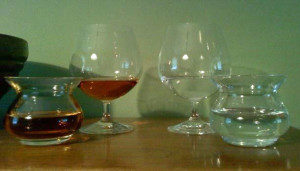Corrected March 13, 2023
By Richard Thomas
Even in the midst of whisk(e)y’s resounding popularity, or perhaps even because of it, there are plenty of people who have never been to a real tasting before. Yet because bourbon, Scotch and other whiskeys are so trendy, going to that first tasting can make one very self-conscious of the etiquette, mindful of what, exactly, is the proper form. Whether it be a VIP tasting event at a convention or a cozy gathering hosted around your own budding collection, here is how you can do it like a veteran.
Glassware and Serving
Plenty of snobs insist on this and that type of glassware, but keep in mind that many Master Distillers in the industry are perfectly happy drinking their own stuff out of tumblers or even Dixie Cups. For a tasting, the only hard and fast rule is to use a glass with a shape akin to a tulip bulb, since this shape concentrates vapors and makes for a better nosing. The exact same principle is used in wine, and the glasses at many tastings look just like small wine glasses.
If you are attending a tasting, of course the glassware will be provided, but now you know why it looks like it does. If you are hosting a tasting and don’t have a set of Glencairns or even snifters, small wine glasses will do just fine.
With apologies to Wild Turkey’s Jimmy Russell, who likes to keep his bourbon in the freezer, the proper temperature for serving whisky is “room temperature,” or a comfortable place between the mid-60s and mid-70s F (18 to 23 C).

If you have a fancy glass, like a NEAT, use it. Otherwise, plain old snifters are fin too.
(Credit: S.D. Peters)
To add or not to add water is a constant question in whiskey circles. This is really a matter of personal taste. If you usually have water, adding a few drops at the start is appropriate. For my part, I never add water until after I have at least nosed the whiskey, and sometimes not at all, because I prefer drinking my whiskey neat whenever possible.
The Swish
The first step in the tasting process is to give the whiskey what Homer Simpson called “the swish,” but is more often referred to as the swill. I don’t like using the word “swill,” however, since it has so many negative, porcine-related connotations.
Give the glass a circular motion to push the liquid around the interior, but without splashing it over the rim. This coats the interior of the glass with whisky, which after a few seconds will increase the vapors inside the tulip bulb of the glass. It also reveals the “legs” of the whisky, or the stripes of liquid dripping back down into the bottom of the glass. You can read how high the alcohol content and how viscous the fluid is through these legs, and what specifically thick or thin legs might translate into is a tea reading exercise beloved among many serious enthusiasts.
Another thing to note after the swish is the appearance of the whiskey. Hold the glass up in good, but indirect light, and observe the color and how it reflects and/or filters light.
The Nosing
If your observation of the legs revealed a particularly thin whiskey, give it another swish before nosing. Place your nostrils just over the glass, about half an inch away, and take a sniff. Don’t snort it, just sniff it.
After that first sniff, go in for further nosings, both before and after you’ve had a sip. Swish the liquid some more, and try putting your nose just inside the glass for a deeper nosing, as well as using just one nostril and then the other to see if there are any differences. Make notes about what scents you detect with each nosing of the whiskey.
The Tasting
Smell and taste are closely related, with smell being the sense with the most direct route into the brain. Because of that, some experts say the nose is really all you need to assess a whiskey, but I think that opinion brushes off that drinking it is the entire point of the exercise. Take a sip, keep the liquid on your tongue for a time, and then swallow. Observe not just how it tastes, but also the texture of the liquid (“mouthfeel”) and how the taste and texture evolve on your palate, and then what you sense after you swallow. Continue observing these things as you take more sips, because just like with the nose, you may detect new things as you proceed or even find the entire profile of the whiskey changes as it opens up.
 The Whiskey Reviewer A World of Whiskey, Poured Every Weekday
The Whiskey Reviewer A World of Whiskey, Poured Every Weekday

You might want to check your editing in this sentence from “The Nosing” paragraph from “Whiskey Tasting for Novices”. It reads:
“Make notes about what scents you detest with each nosing of the whiskey.”
Did you really mean to use the word “detest” ? Or should it read “detect” ?
Regards
Typos happen. Thanks.